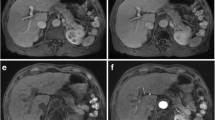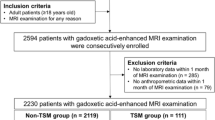Abstract
Purpose
To determine whether patients undergoing multiple gadoxetate disodium-enhanced magnetic resonance (MR) examinations who experienced transient severe motion (TSM) in the arterial phase were affected by the TSM noted in the first examination.
Materials and methods
214 patients who underwent three or more repeated gadoxetate disodium-enhanced MR imaging were retrospectively analyzed. Three radiologists scored all of the examinations demonstrating a motion artifact using a five-point rating scale. Risk factor analysis and comparison of TSM recurrence rates were performed in the whole study population as well as in a subpopulation of patients with TSM.
Results
The overall incidence of TSM was 5.9% (54/922), which was observed in 40 patients. Thirty-two patients had one episode of TSM, and eight patients had recurrent TSM. Although TSM in the first examination increased the risk of recurrent TSM in the whole population (OR 24.45; P < 0.001), the incidence of recurrent TSM was low (2.4%, 22/922). On subpopulation analysis, TSM in the first examination did not influence recurrent TSM (OR 0.36; P = 0.250).
Conclusion
Patients undergoing multiple gadoxetate disodium-enhanced MR examinations who experienced recurrent TSM were not affected by TSM in the first examination. Therefore, a single episode of TSM should not be considered a risk factor of recurrent TSM.


Similar content being viewed by others
References
Bashir MR, Gupta RT, Davenport MS, et al. (2013) Hepatocellular carcinoma in a North American population: does hepatobiliary MR imaging with Gd-EOB-DTPA improve sensitivity and confidence for diagnosis? J Magn Reson Imaging 37(2):398–406. doi:10.1002/jmri.23818
Chung YE, Kim MJ, Kim YE, et al. (2013) Characterization of incidental liver lesions: comparison of multidetector CT versus Gd-EOB-DTPA-enhanced MR imaging. PLoS ONE 8(6):e66141. doi:10.1371/journal.pone.0066141
Muhi A, Ichikawa T, Motosugi U, et al. (2011) Diagnosis of colorectal hepatic metastases: comparison of contrast-enhanced CT, contrast-enhanced US, superparamagnetic iron oxide-enhanced MRI, and gadoxetic acid-enhanced MRI. J Magn Reson Imaging 34(2):326–335. doi:10.1002/jmri.22613
Grazioli L, Bondioni MP, Haradome H, et al. (2012) Hepatocellular adenoma and focal nodular hyperplasia: value of gadoxetic acid-enhanced MR imaging in differential diagnosis. Radiology 262(2):520–529. doi:10.1148/radiol.11101742
Choi JY, Lee JM, Sirlin CB (2014) CT and MR imaging diagnosis and staging of hepatocellular carcinoma: part I. Development, growth, and spread: key pathologic and imaging aspects. Radiology 272(3):635–654. doi:10.1148/radiol.14132361
Choi JY, Lee JM, Sirlin CB (2014) CT and MR imaging diagnosis and staging of hepatocellular carcinoma: part II. Extracellular agents, hepatobiliary agents, and ancillary imaging features. Radiology 273(1):30–50. doi:10.1148/radiol.14132362
Schmid-Tannwald C, Herrmann K, Oto A, et al. (2012) Optimization of the dynamic, Gd-EOB-DTPA-enhanced MRI of the liver: the effect of the injection rate. Acta Radiol 53(9):961–965. doi:10.1258/ar.2012.120186
Tamada T, Ito K, Yoshida K, et al. (2011) Comparison of three different injection methods for arterial phase of Gd-EOB-DTPA enhanced MR imaging of the liver. Eur J Radiol 80(3):e284–288. doi:10.1016/j.ejrad.2010.12.082
Motosugi U, Ichikawa T, Sano K, et al. (2011) Double-dose gadoxetic Acid-enhanced magnetic resonance imaging in patients with chronic liver disease. Invest Radiol 46(2):141–145. doi:10.1097/RLI.0b013e3181f9c487
Davenport MS, Viglianti BL, Al-Hawary MM, et al. (2013) Comparison of acute transient dyspnea after intravenous administration of gadoxetate disodium and gadobenate dimeglumine: effect on arterial phase image quality. Radiology 266(2):452–461. doi:10.1148/radiol.12120826
Pietryga JA, Burke LM, Marin D, Jaffe TA, Bashir MR (2014) Respiratory motion artifact affecting hepatic arterial phase imaging with gadoxetate disodium: examination recovery with a multiple arterial phase acquisition. Radiology 271(2):426–434. doi:10.1148/radiol.13131988
Davenport MS, Caoili EM, Kaza RK, Hussain HK (2014) Matched within-patient cohort study of transient arterial phase respiratory motion-related artifact in MR imaging of the liver: gadoxetate disodium versus gadobenate dimeglumine. Radiology 272(1):123–131. doi:10.1148/radiol.14132269
Bashir MR, Castelli P, Davenport MS, et al. (2015) Respiratory motion artifact affecting hepatic arterial phase MR imaging with gadoxetate disodium is more common in patients with a prior episode of arterial phase motion associated with gadoxetate disodium. Radiology 274(1):141–148. doi:10.1148/radiol.14140386
Motosugi U, Bannas P, Bookwalter CA, Sano K, Reeder SB (2016) An investigation of transient severe motion related to gadoxetic acid-enhanced MR imaging. Radiology 279(1):93–102. doi:10.1148/radiol.2015150642
Davenport MS, Bashir MR, Pietryga JA, et al. (2014) Dose-toxicity relationship of gadoxetate disodium and transient severe respiratory motion artifact. AJR Am J Roentgenol 203(4):796–802. doi:10.2214/ajr.13.11587
Kim SY, Park SH, Wu EH, et al. (2015) Transient respiratory motion artifact during arterial phase MRI with gadoxetate disodium: risk factor analyses. AJR Am J Roentgenol 204(6):1220–1227. doi:10.2214/ajr.14.13677
Cruite I, Schroeder M, Merkle EM, Sirlin CB (2010) Gadoxetate disodium-enhanced MRI of the liver: part 2, protocol optimization and lesion appearance in the cirrhotic liver. AJR Am J Roentgenol 195(1):29–41. doi:10.2214/ajr.10.4538
Ringe KI, Husarik DB, Sirlin CB, Merkle EM (2010) Gadoxetate disodium-enhanced MRI of the liver: part 1, protocol optimization and lesion appearance in the noncirrhotic liver. AJR Am J Roentgenol 195(1):13–28. doi:10.2214/ajr.10.4392
Donner A, Eliasziw M (1987) Sample size requirements for reliability studies. Stat Med 6(4):441–448
Luetkens JA, Kupczyk PA, Doerner J, et al. (2015) Respiratory motion artefacts in dynamic liver MRI: a comparison using gadoxetate disodium and gadobutrol. Eur Radiol 25(11):3207–3213. doi:10.1007/s00330-015-3736-x
Gutzeit A, Matoori S, Froehlich JM, et al. (2016) Reduction in respiratory motion artefacts on gadoxetate-enhanced MRI after training technicians to apply a simple and more patient-adapted breathing command. Eur Radiol 26(8):2714–2722. doi:10.1007/s00330-015-4086-4
Acknowledgments
The authors thank the MR radiographers of our unit, Mr. Hyun-Geun Lee, Mr. Keun-Taek Oh, and Mr. Eun-Seong Kim, for technical assistance with MR studies. The authors also thank Ha Yan Kim at the Biostatistics Collaboration Unit, Medical Research Center, College of Medicine, Yonsei University for statistical assistance.
Author information
Authors and Affiliations
Corresponding author
Ethics declarations
Funding
No funding was received for this study.
Conflict of interest
The authors declare that they have no conflict of interest.
Ethical approval
All procedures performed in studies involving human participants were in accordance with the ethical standards of the institutional and/or national research committee and with the 1964 Helsinki declaration and its later amendments or comparable ethical standards. This study does not contain any studies with animals performed by any of the authors. For this type of study formal consent is not required.
Informed consent
Statement of informed consent was not applicable since the manuscript does not contain any patient data.
Rights and permissions
About this article
Cite this article
Im, W.H., Song, J.S., Park, E.H. et al. Transient severe motion in the arterial phase during gadoxetate disodium-enhanced MR imaging: evaluation of patients with multiple MR examinations. Abdom Radiol 42, 2393–2401 (2017). https://doi.org/10.1007/s00261-017-1145-0
Published:
Issue Date:
DOI: https://doi.org/10.1007/s00261-017-1145-0




